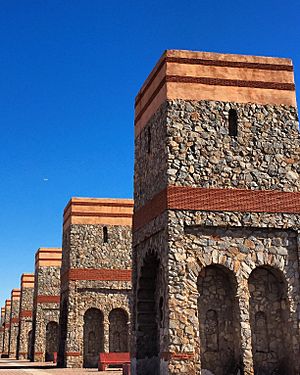Seven Saints of Marrakesh facts for kids
The Seven Saints of Marrakesh are seven important historical Muslim figures buried in the city of Marrakesh, Morocco. These figures were famous Muslim judges, scholars, or Sufi saints. They were respected for their strong faith and special qualities. Their tombs are part of a very old yearly pilgrimage, called a ziyara. During this pilgrimage, people visit and pray at each of their tombs over seven days.
Contents
History of the Seven Saints Pilgrimage
The tradition of visiting the tombs of the Seven Saints of Marrakesh began in the late 1600s. It was started by the Alaouite ruler, Sultan Moulay Isma'il, who ruled from 1672 to 1727. The sultan wanted to use the popularity of these religious figures to strengthen his own power. He also wanted to make Marrakesh a more important spiritual city.
At that time, there was another popular pilgrimage to "Seven Saints" of the Regraga Berber tribe near Essaouira. Moulay Isma'il chose mostly Arab saints for the new Marrakesh pilgrimage. This helped to balance the influence of the Berber saints. He asked a respected religious leader, Abu 'Ali al-Hasan al-Yusi, to help set up this new pilgrimage in Marrakesh.
The pilgrimage helped Marrakesh become even more famous for its spiritual importance. It also brought many visitors, which helped the city's economy. The "Seven Men" (Sab'atu Rijal) became another name for Marrakesh itself. Even later sultans, who had different religious views, still supported these shrines. They even helped to restore or expand the tombs of the Seven Saints.
Today, the pilgrimage is not as widely followed as it once was. However, the tombs and religious centers (called zawiyas) are still very important places in the city. In 2005, a special monument was built near Bab Doukkala to honor the Seven Saints. This area is now known as the Seven Saints' Square.
How the Pilgrimage Works
The pilgrimage usually lasts for most of a week. It starts on a Tuesday and finishes on a Monday. The journey goes in a circle around the city. It begins in the southeast and ends in the southwest. This circular path is similar to the way pilgrims walk around the Kaaba in Mecca. Each day, pilgrims stop to pray at a different tomb.
- On Tuesday, the first stop is the tomb of Sidi Yusuf ibn 'Ali Sanhaji. This tomb is located near Bab Aghmat, a gate on the southeast side of the city.
- On Wednesday, pilgrims enter the city to visit the tomb of Qadi 'Iyyad.
- On Thursday, they leave the city through Bab Aylan. They then pass Bab el-Khemis to reach the mausoleum of Sidi Bel Abbes as-Sabti. This shrine was outside the city walls until the 1700s.
- On Friday, the journey continues to the mausoleum of Sidi Ben Sliman al-Jazuli.
- On Saturday, pilgrims visit the tomb of Sidi Abd al-'Aziz at-Taba'a. He was a student of al-Jazuli.
- On Sunday, they go to the mausoleum of Sidi Abdallah al-Ghazwani. He was a student of at-Taba'a.
- Finally, on Monday, the pilgrimage ends at the tomb of Sidi al-Suhayli. This tomb is near Bab er-Robb, a gate on the southwest side of the city.
The Seven Saints and Their Shrines
Here are the Seven Saints of Marrakesh. They are listed in the order they passed away. There are different ways to spell their names because they are translated from Arabic. The word "Sidi" is a title of respect often used in North Africa.
- Qadi 'Iyyad ibn Musa (died 1149): He is buried in a mausoleum near Bab Aylan, one of the western gates of the old city.
- Sidi al-Suhayli (died 1185): His tomb is in a cemetery named after him. It is just outside Bab er-Robb.
- Sidi Yusuf ibn 'Ali as-Sanhaji (died 1196): He is buried in a zawiya dedicated to him. This is located outside Bab Aghmat.
- Sidi Abu al-Abbas as-Sabti (died 1204): He is buried at the Zawiya of Sidi Bel Abbes in the northern part of the old city. His tomb was one of the first popular zawiyas in Marrakesh. Even the Jewish people of the city respected him.
- Sidi Ben Sliman al-Jazuli (died 1465): He was the only saint who did not originally die in Marrakesh. His body was moved to Marrakesh by the Saadians in 1523–24. His tomb is at the Zawiya of Sidi Ben Slimane, south of Sidi Bel Abbes's zawiya.
- Sidi Abd al-'Aziz at-Taba'a (died 1508): He is buried in the Zawiya of Sidi Abd el-Aziz. This is north of the Mouassine Mosque and south of al-Jazuli's zawiya.
- Sidi Abdallah al-Ghazwani (died 1528): He is buried in a zawiya just northwest of the Jemaa el-Fnaa square.
Gallery
-
The tomb of Qadi 'Iyyad
-
The mausoleum of al-Suhayli, located in a cemetery along the southwestern walls of the city, near Bab er-Robb
-
The central courtyard of the Zawiya of Sidi Bel Abbes. The mausoleum is on the right and the minaret of the complex stands on the left.
-
The mausoleum chamber of Sidi Bel Abbes
See also
 In Spanish: Siete santos de Marrakech para niños
In Spanish: Siete santos de Marrakech para niños










